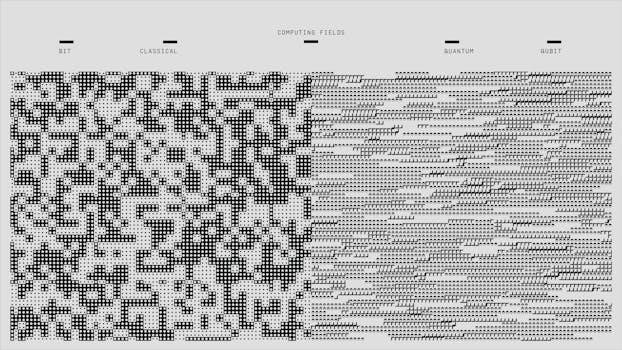Quantum Mechanics for Dummies⁚ A Beginner’s Guide PDF
This guide offers a non-technical introduction to quantum mechanics, exploring its fundamental principles without complex mathematics․ It delves into the behavior of matter and energy at atomic and subatomic scales, contrasting it with classical physics․
Quantum mechanics, often perceived as a complex and bizarre field, is fundamentally the study of how the universe operates at the smallest scales – atoms and subatomic particles․ It’s a framework that provides a powerful description of the motions and interactions of these tiny entities․ This realm, far removed from our everyday experiences, requires a different set of rules than classical physics․ While classical physics suffices for describing larger objects, quantum mechanics becomes essential when dealing with the microscopic world․ This field has revolutionized our understanding, enabling technological applications and challenging our perception of reality․ It reveals that properties like energy and angular momentum are not continuous but come in discrete packets called quanta․ This is the foundation for quantum chemistry, quantum field theory, and quantum information science․ Understanding the basics of quantum mechanics opens a door to a new understanding of nature, even without intricate math․
Basic Concepts of Quantum Mechanics
At the heart of quantum mechanics lies the concept that both radiation and matter exhibit characteristics of both particles and waves – a phenomenon known as wave-particle duality․ This means that entities like electrons can behave as both localized particles and delocalized waves․ Another fundamental concept is quantization, which dictates that certain properties, such as energy, are not continuous but exist in discrete units or quanta․ These quanta are the smallest units of these properties․ The theory also introduces the notion of probability, where we cannot predict the exact outcomes of measurements but instead calculate the likelihood of various possibilities․ This contrasts with the deterministic nature of classical physics․ Furthermore, superposition is a crucial concept, describing the ability of a quantum system to exist in multiple states simultaneously until measured; These concepts form the basis for understanding the behavior of the quantum world․
Quantum Mechanics vs․ Classical Physics
Classical physics, which governs our everyday macroscopic world, operates on principles of determinism, where we can predict future states with precise certainty, given initial conditions․ Objects have definite positions and velocities at any given time; However, quantum mechanics, which describes the microscopic world of atoms and subatomic particles, introduces a different set of rules․ Here, we cannot know both the position and momentum of a particle with absolute precision simultaneously, due to the uncertainty principle․ Instead of precise trajectories, we deal with probabilities of a particle being found in a particular location․ Unlike classical physics, which assumes continuous values for properties like energy, quantum mechanics states that these properties are quantized, meaning they can only take specific discrete values․ Superposition, a concept alien to classical physics, allows particles to exist in multiple states at once․ These differences highlight the fundamentally different nature of the quantum realm compared to our macroscopic experience․
Wave-Particle Duality in Quantum Mechanics
One of the most perplexing aspects of quantum mechanics is the concept of wave-particle duality, where entities like electrons and photons exhibit both wave-like and particle-like characteristics․ In classical physics, something is either a wave or a particle, never both․ However, in the quantum realm, particles can demonstrate wave behavior, such as interference and diffraction, and waves can display particle-like behavior, such as being absorbed or emitted in discrete packets or quanta․ This duality is not a case of something switching between being a wave or a particle, but rather that these are two aspects of a single quantum entity․ The wave nature is described by a wave function, which dictates the probability of finding a particle at a particular location․ The particle aspect manifests when the entity interacts with other matter or is measured․ This dual nature is fundamental to the understanding of quantum phenomena and is demonstrated in experiments like the double-slit experiment, where particles show interference patterns․
Schrödinger’s Equation⁚ A Core Concept

At the heart of quantum mechanics lies the Schrödinger equation, a mathematical expression that describes how the quantum state of a physical system changes over time․ This equation is analogous to Newton’s second law in classical mechanics, but it applies to the microscopic world․ Unlike Newton’s laws, which predict the exact position and momentum of a particle, the Schrödinger equation describes the wave function, which is a mathematical function that contains all information about a particle․ The square of the wave function gives the probability of finding the particle in a particular location․ There are two main forms of the Schrödinger equation⁚ time-dependent, which describes how a system evolves with time, and time-independent, which describes systems with constant energy․ Solving this equation provides information about the energy levels, probabilities, and other properties of quantum systems․ It’s a fundamental tool in quantum physics, enabling us to understand and predict the behavior of atoms, molecules, and other quantum systems․
Quantum Superposition Explained
Quantum superposition is a fundamental concept in quantum mechanics that defies classical intuition․ It describes the ability of a quantum system, such as an electron, to exist in multiple states simultaneously․ Think of it like a coin spinning in the air – it’s neither heads nor tails until it lands․ In the quantum world, a particle can be in a “superposition” of different positions, momenta, or even spin states at the same time․ This isn’t simply a matter of our not knowing which state it is in; it’s genuinely in all of those states at once․ The probability of finding the particle in any particular state is given by the square of the magnitude of the amplitude associated with that state․ When we measure the particle, this superposition collapses, and it is found in just one of the possible states․ This phenomenon is essential to many quantum technologies, including quantum computing and quantum communication․
Quantum Entanglement Basics
Quantum entanglement is another bizarre but crucial aspect of quantum mechanics․ It occurs when two or more particles become linked in such a way that they share the same fate, no matter how far apart they are․ This interconnectedness means that the state of one particle instantaneously affects the state of the other, regardless of the distance separating them․ For example, if two entangled particles have opposite spins, measuring the spin of one particle will immediately determine the spin of the other․ The correlation between these particles is not due to any classical connection, but rather a fundamental quantum phenomenon․ This ‘spooky action at a distance,’ as Einstein called it, implies that information can be transmitted instantaneously across vast distances․ This effect has led to many technological advances, for example, in quantum computing and quantum communications․ It is not about sending information faster than light, but about correlation․
The Role of Complex Numbers in Quantum Mechanics
Complex numbers, which involve the imaginary unit ‘i’ (where i² = -1), play a fundamental role in quantum mechanics․ Unlike classical physics, where real numbers are sufficient, quantum mechanics requires complex numbers to describe the wave-like behavior of particles․ These numbers are crucial in representing the quantum state of a particle, encapsulating both its magnitude and phase․ The phase, an element that is absent in classical physics, is very important for determining how quantum states interfere with each other․ The use of complex numbers is particularly apparent in the famous Schrödinger equation, which describes how quantum states evolve over time․ Operations on quantum states, such as rotations, also involve the use of complex numbers․ These numbers are essential for calculating probabilities and understanding the superposition of quantum states; They allow us to describe wave functions, essential mathematical objects of quantum mechanics․ Without complex numbers, the theoretical framework of quantum mechanics would be incomplete, unable to accurately capture the behavior of quantum systems․

The Loss of Determinism in Quantum Physics
One of the most profound departures of quantum mechanics from classical physics is the loss of determinism․ In classical physics, if you know the initial conditions of a system, you can predict its future with complete certainty․ However, in the quantum world, this is not possible․ Quantum mechanics, instead, deals with probabilities․ The outcome of a measurement on a quantum system is not predetermined, but is probabilistic․ For example, you can calculate the probability of an electron being in a certain location or having a particular momentum, but you cannot know with certainty․ This inherent randomness is not due to a lack of knowledge, but is a fundamental aspect of quantum reality․ The loss of determinism is captured by Heisenberg’s uncertainty principle, which states that certain pairs of physical properties, such as a particle’s position and momentum, cannot both be known with perfect accuracy․ This leads to the idea that the act of measurement itself can influence the quantum state, further emphasizing the probabilistic nature of quantum mechanics․ This shift from certainty to probability is what distinguishes quantum mechanics from our everyday experience․
Quantum Mechanics and Atomic Structure
Quantum mechanics provides the framework for understanding the structure of atoms and how they behave․ It explains why electrons occupy specific energy levels or orbitals around the nucleus, instead of collapsing into it as predicted by classical physics․ These energy levels are quantized, meaning electrons can only exist at certain discrete energies․ The behavior of electrons in atoms is described by wave functions, which provide probabilities for finding an electron in a particular region of space․ Quantum numbers, derived from solving the Schrödinger equation, characterize these energy levels and orbital shapes․ These numbers dictate how electrons are arranged in an atom, which in turn determines the chemical properties of elements․ Quantum mechanics also explains how atoms interact with light, absorbing or emitting photons to jump between energy levels․ This understanding forms the basis for spectroscopy, a technique that allows us to study the composition of matter by analyzing the light it emits or absorbs․ Quantum mechanics is essential for understanding the periodic table and the chemical bonding between atoms, allowing the prediction of molecular properties․

Experimental Evidence for Quantum Mechanics
Numerous experiments have provided compelling evidence for the validity of quantum mechanics․ The photoelectric effect, where light striking a metal surface releases electrons, demonstrates the particle-like nature of light (photons) and their quantized energy․ Atomic spectra, which show discrete lines of light emitted by atoms, confirm that electrons occupy specific energy levels․ The Stern-Gerlach experiment, which showed that atoms have quantized angular momentum, revealed the existence of spin as an intrinsic quantum property․ Electron diffraction experiments, where electrons behave like waves and create interference patterns, confirmed wave-particle duality, a cornerstone of quantum mechanics․ The double-slit experiment, using both photons and electrons, further illustrates this wave-like behavior and the concept of superposition․ More recently, experiments on quantum entanglement and quantum teleportation have demonstrated non-classical correlations between particles, further validating the counterintuitive predictions of quantum theory․ These experiments highlight the profound difference between the quantum world and classical physics and show that the seemingly bizarre predictions of quantum theory match experimental observations․
Technological Applications of Quantum Mechanics
Quantum mechanics is not just a theoretical framework; it underpins many technologies that are fundamental to modern life․ The development of transistors, crucial components of all electronic devices, relies heavily on understanding quantum behavior in semiconductors․ Lasers, used in everything from barcode scanners to medical procedures, operate based on quantum principles of stimulated emission․ Magnetic Resonance Imaging (MRI), a vital diagnostic tool, utilizes the quantum phenomenon of nuclear spin․ Quantum chemistry, which uses quantum mechanics to understand chemical reactions, aids in the design of new materials and drugs․ Furthermore, quantum mechanics is driving advancements in quantum computing, which has the potential to revolutionize computation by harnessing quantum superposition and entanglement to solve complex problems that are intractable for classical computers․ Other emerging quantum technologies include quantum cryptography for secure communication and quantum sensors for high-precision measurements․ These applications demonstrate the transformative power of quantum mechanics, extending its influence far beyond the laboratory into our daily lives and shaping the future of technology․
Further Resources for Learning Quantum Mechanics

